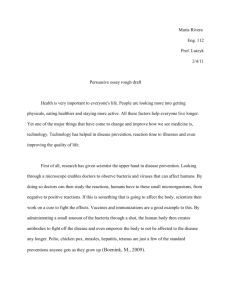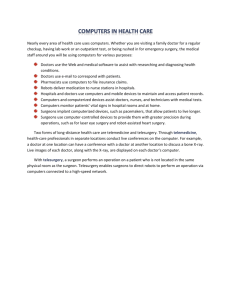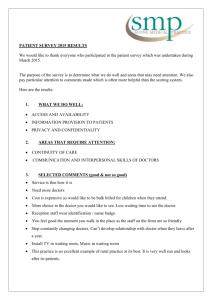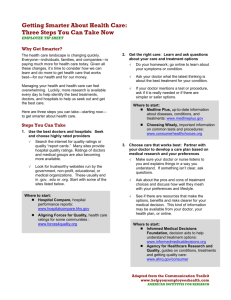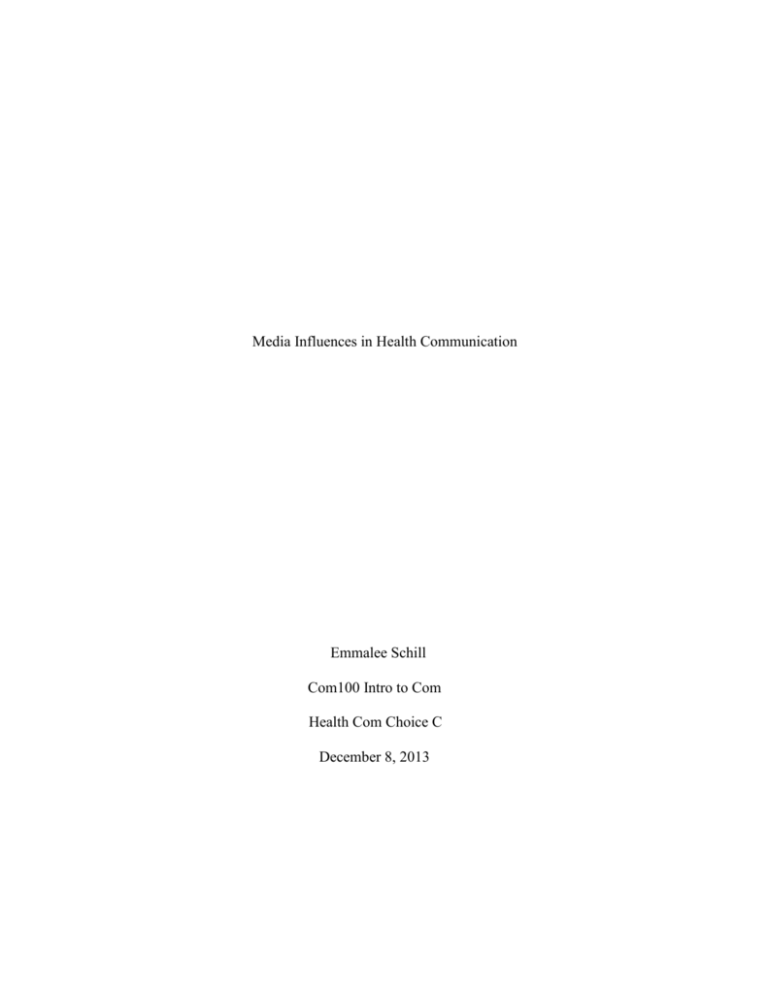
Media Influences in Health Communication
Emmalee Schill
Com100 Intro to Com
Health Com Choice C
December 8, 2013
Schill 1
Abstract
Media displays many different patient provider relationships, which impacts health
and health communication. I will be looking at the different patient-provider roles in
three episodes in three different television series. The episodes that I will analyze
will be from the series House, Greys Anatomy, and Private Practice. I will examine
how patient-provider roles alter by having different processes, cultures, and
industries. Patient provider interactions explore the communication strategies and
messages used by physicians and patients during medical encounters. There are
different types of patient provider relationships, such as patient-centered and
doctor-centered. Life style choices related to health do not always imitate what is
seen in television episodes. TV may have set a view for how people think health and
health communication is supposed to be, but there are many case studies that
confirm that watching something does not cause a person to behave in a specific
way or for them to disregard a personal responsibility. It does, however, put into
perspective all the different patient provider relationships and how they affect
people in their daily lives reflecting how they view health and health
communication.
Schill 2
Media displays many different patient-provider relationships, which impacts health
and health communication. I will be looking at the different patient-provider roles in
three episodes in three different television series. The episodes that I will analyze will be
from the series House, Grey’s Anatomy, and Private Practice. I will examine how patientprovider roles vary by having different processes, cultures, and industries. Patient
provider interactions explore the communication strategies and messages used by
physicians and patients during medical encounters. There are different types of patient
provider relationships, such as patient-centered and doctor-centered. Also, life style
choices related to health do not always imitate what is seen in television episodes. TV
may have established an idea of how people should perceive health and health
communication, but there are many case studies that confirm that watching something
does not necessarily influence a person’s behavior in a negative way or cause them to be
personally irresponsible. It does, however, put into perspective all the different patient
provider relationships and how they affect people in their daily lives and their view of
health and health communication.
House, Grey’s Anatomy, and Private practice display different types of patient
provider relationships and the impact they have on health of the patients and health
communication. While the patient provider relationships in these television shows differ
from people to people, they seem to rotate between patient-centered and doctor-centered.
The patient-centered role is presented by communicative strategies that focus on the
patient's perspective in interaction. The patients tend to ask open-ended questions,
resulting in more conversation. By requesting opinions and concerns they can have a
better understanding of what the doctor is saying. They also ask what kinds of support
Schill 3
and counseling are available for them. The other role that is demonstrated in these shows
is the doctor-centered role where doctors often ask closed-ended questions, which
discourage patient feedback resulting in less conversation. The doctors also interrupt the
patient and give directions, preventing the patients from voicing their concerns. In these
different communication techniques there are distinctive ways in which the doctors
provide information, use partnership-building strategies, and reassure and encourage the
patient. Doctors vary these strategies with different patients in the episodes according to
their health care status, age, gender, or racial background. Patients vary their
communication styles too, and according to Mohan J Dutta, different patients in different
episodes “range from being expressive and communicative to being submissive and
passive during the physician-patient interaction (“Health Communication: Trends and
Future Directions”, 65).” These different types of patient-provider relationships are all
apparent in the episodes of House, Greys Anatomy, and Private Practice. As well as
looking at how media displays health interactions between patients and doctors, I will
examine how it shapes health attitudes and ultimately influences health behaviors.
To fully understand how these episodes impact patient provider relationships in health
and health communication, it is important to understand how patient provider
relationships differ in the health care world and how media inflects them. The articles
that best explain this are “Emphasizing ‘Communication’ in Health Communication,”
“Perceptions of Health Care Providers' Communication: Relationships Between PatientCentered Communication and Satisfaction,” and “Primary Sources of Health Information:
Comparisons in the Domain of Health Attitudes, Health Cognitions, and Health
Behaviors.” These articles draw on health communication, relationships between patients
Schill 4
and providers, and health in media. Health communication is “the art and technique of
informing, influencing, and motivating individual, institutional, and public audiences
about important health issues (Parrott, 751).” This article describes how health
communication is vital and has an impact on health outcomes. Often times
communication behavior can be result in positive or negative health outcomes. A
patient’s reaction to news that a doctor is giving them is dependent on how the doctor
tells the patient, and this is directly relevant to how doctors form relationships with their
patients. The literature that I will be using to discuss patient provider relationships looks
at communication practices of many doctors and how it can impact patient outcomes.
Their study concluded that the more that health care providers use patient centered
communication there were more positive outcomes, like patient satisfaction. My other
source on health and media describes how television is a primary source of health
information for individuals who are not concerned a great deal on health. Television is
used as entertainment education, so certain shows incorporate health to entertain as well
as educate the public. This literature will help guide an understanding of how patients
interact with doctors and the outcomes from those interactions as well as provide an
understanding of how media portrays health and health communication. The media I am
going to be examining gives a look at how health care and communication is portrayed.
The first episode I will be examining is of the series House called The Down Low.
The episode opens up with a group of people engaging in a drug deal. Someone pulls out
a gun in the fight that results in one man going down unconscious, but he wasn’t shot. He
is taken to the hospital where House examines his wounds. House meets with his
colleagues where they discuss the possible factors of the patient’s loud induced vertigo.
Schill 5
House then interrogates the patient’s friend, where he accuses them of being drug dealers.
House bugs the patient’s room to find out what drugs he is on that is making him sick.
Before he can run tests, the patient demands to be discharged. Two doctors follow the
patient in a car after he is discharged and the patient is brought back to the hospital for
them to run more tests because his symptoms were continuing. House discovers that the
patient is actually a cop and has bugged his own room. The patient tells the doctors the
plan he has to bust the drug deal and asks them to keep him a live for one more day then
he will tell them everything they need to know about his medical history. They plan to
drug the patient’s friend to get him to talk but he knows he was drugged and the plan falls
through. Eventually the friend takes the doctor to where the patient lives and they
discover he has a fungal infection in his lungs. The patient tells his friend that he won’t
be able to make it to the drug deal because he is getting sicker. It turns out the doctors
misdiagnosed the patient and they tell him he has an autoimmune disease. The drug deal
ends up getting busted but the patient dies.
In this episode of House there are many representations of health communication. The
patient provider roles in this episode are doctor-centered. Although there are instances
where House asks questions to spark conversation, the patient doesn’t give him any
information about his medical history. The patient provider role is doctor-centered
because House is very dominant in conversation. House tells the patient that he needs a
head CT or he will get worse, so it gives the patient no option but to do what the doctor
says even though he doesn’t want to. To reduce the uncertainty of the patient, the doctors
could have used the uncertainty reduction theory, which is essentially, “information
provided by the health care provider early in the interaction that reduces patient anxiety
Schill 6
and encourage further communication (Wanzer, 365).” This could have been done by
house providing information about him or what to expect. Instead, House is forced to use
his diagnostic skills to determine who the patient is and what is wrong with him since he
doesn’t share any information. The process he uses to get the information he is seeking is
by bugging the patient’s room as well as name-calling. As an industry, the hospital
disregards the need for cops, and even though they know he is a drug dealer they merely
manage the patient medically. The industry still functions even though House uses
unmethodical ways to talk to patients and it turns a blind eye because he gets results. His
colleagues even believe that bugging the patient’s room is a better idea than blindly
running tests. In this episode the life choices of the patient relates directly to his health
issue. At first, the doctors believed that it was a drug that was making the patient sick
because he is a drug dealer. Then they believed it was a fungal infection in his lungs from
living in a Laundromat. The ultimate factor was putting off treatment of his autoimmune
disease. There are negative impacts of the portrayals of health and health communication
in the episode. The impact of the portrayal of health communication on the patient was
negative. The Patient was very with holding about the information that the doctors
needed. Since the doctors had no medical background on the patient they ran useless tests
until the patient died.
The second episode I will be examining is in the series Grey’s Anatomy called The
Girl With No Name. This episode starts out by a group of doctors conversing about
buying the hospital after a fatal plane crash that jeopardized many of their lives. The next
scene is of a doctor, Alex, tending to a newborn child. Alex goes to talk to the family and
explains to them what is wrong with their child. After no response from the family he
Schill 7
says they will be performing surgery on the baby to correct his problem. After Alex pulls
the father aside he learns that the father and mother don’t know each other very well and
the baby is a result of a hookup. This is a life-style choice that is related to health. The
two people had unsafe sex, which resulted in a pregnancy. Then there is a child patient
that has cancer and his doctor persuades the parent to let the doctors try a new surgery.
When the doctors do not get the new surgery approved, the doctor tells the patient to
leave and go to a hospital that will take care of them. She then tells another doctor she is
going to quite because the hospital makes her feel small. The doctor that she told gathers
the group of doctors that are discussing the options about buying the hospital. She tells
them that their colleague is threatening to quite so they need to make a decision about the
hospital fast. They all decide that they should buy the hospital with the money they are
suing from the hospital and getting from the plane crash they were in.
As well as the episode of House, this episode of Greys Anatomy has many
representations of health communication. One of the doctors in the episode uses a doctorcentered patient-provider role. This is demonstrated when Alex is consulting with his
patient’s parents. Although there is a lot of conversation, it is mostly between the mother
and father of the child that is the patient. Alex explains the surgery and does not receive
feedback from the parents. He does display a patient-centered relational role by using
clarity with the father. He pulls the father aside and tells him he knows these things can
be scary and uses empathy. Alex makes an effort to “communicate clearly to avoid
misunderstandings, lower patient anxiety, and reduce uncertainty about health related
processes in general (Wanzer, 366).” Alex pulls the father aside to avoid
misunderstandings and once they have communicated there seem to be no further
Schill 8
misunderstandings between the patient and doctor. After this interaction Alex does not
use any partnership-building strategies. When the two parents are struggling to make a
decision about their baby’s surgery he does not use reassurance to encourage them.
Another doctor that is speaking with her patient’s parent displays another representation
of health communication. This doctor uses more of a steady patient-centered
communication technique. The doctor uses uncertainty reduction theory when convincing
her patient’s dad about a new surgery she wants to try on his child. While hearing about
the surgery the dad is experiencing doubts and uncertainties about predicting outcomes.
The doctor uses this process by reducing his uncertainty by applying “nonverbal
affiliative expressiveness (Wanzer, 366)” that reduces physical and physiological
distance between them selves. To assure the dad that everything will be all right the
doctor uses a nonverbal communication skill and puts her hand on his arm. This doctor is
an example of a positive portrayal of health communication. The industry of healthcare is
explored in this episode when the hospital is getting sued. The chief of the hospital makes
no time to inform the doctors about what is happening. The doctors then think he is
disregarding them, which makes them feel small. Many doctors threaten to quit because
of his tentativeness, which directly affects the health care of the industry.
The third episode that I will be examining is from the series Private Practice called
The Letting Go. The episode starts by a patient waking after surgery to her brother and
doctor. She got into an accident with her brother, but he just has a couple bruises. The
doctor leaves the room and the brother follows him and they get into an argument
because the doctor doesn’t want the brother being her doctor, even though he is one at the
hospital. When the brother enters the room his sister is out of the hospital bed and is
Schill 9
asking for him to take her home. The brother is in a hard place because he wants to act
like her doctor and say no, but he ultimately says yes because he has an emotional
relationship with the patient as brother and sister. The patient’s doctor thinks it’s a bad
idea but lets it happen anyway. He tells his colleague doctor about the situation and she
offers to help by making a logical appeal while he makes a logical appeal. She suggests
to the brother that he could hire someone to take care of her if he is not going to take her
to the hospital. The brother tries to do it himself but ultimately asks the doctors what kind
of help there is. The next patient is brought in and is a paramedic at the hospital who got
in between a fight. His girlfriend shows up and the doctor, who was her husband lets her
put his shoulder back into place. The boyfriend see’s his girlfriend and her husband
talking and decides that she should try and get back together with her husband because he
doesn’t want to get in between her family.
This episode has many representations of health communication as well as the other
episodes. The first patient, who is the sister, exemplifies many patient provider roles
while she is being taken care of. Her First doctor uses more of a doctor-centered role and
provides logical appeal. He tells the patient what he should do and interrupts him while
he talks so he cannot voice his opinion. This doesn’t allow them to connect emotionally,
so another doctor talks to him to appeal this way. This doctor has more of a patientcentered relationship and according to Wanzer this leads to satisfaction with physicians
by using immediacy behaviors, empathy and listening. She used immediacy behaviors by
touching his arm and using eye contact while speaking to him. This let him know that
they were genuinely concerned. By these two doctors working together they appealed
logically and emotionally, trust was built, and the patient’s brother actively listened to
Schill 10
what the doctors were suggesting. This allowed for more conversation and partnershipbuilding strategies. The brother was then able to perform a patient-centered role and
asked for what kinds of help there was for his sister. And according to Dutta this
communicative strategy invited the patient's perspective in the consultation such as
“requests for opinions and concerns, and offers of support and counseling (“Health
Communication: Trends and Future Directions,” 71).” The industry of health care is
represented in this episode when all of the patients are some how involved with the
hospital. Health care is represented by doctors treating doctors, or family members. Life
style choices in this episode are related to health by the patients. There is a patient that is
in the hospital that just got out of jail, which leads to her depression. The cause of the
patient going to jail made her depressed and she mentions suicide.
There are many themes related to health and health communication in the episodes I
examined of House, Grey’s Anatomy, and Private Practice. The themes that are
reoccurring in all of these episodes are the similar patient provider roles. There are many
instances where doctor centered and patient centered roles are performed. The most
successful kind of health communication that was represented was patient-centered. The
way that the doctors communicated with their patients led to more satisfactory outcomes.
Another theme that was prevalent through out was in regards to relationships in the
hospital between doctors. Many doctors were either in a relationship with another doctor
or hooking up with other doctors. These themes played an important role in how health
care and communication was portrayed.
A result of watching these TV shows can have a positive affect of how people
understand health care and health communication. As stated by Dutta-Bergman in
Schill 11
Primary Sources of Heal Information, to have a positive impact on people it determines
what health orientation the person has. For these TV episodes to have a positive impact
on people it matters how health conscious they are, how they look at the health
information, their health-oriented beliefs, and what healthy activities they partake in.
People that are highly motivated regarding their health are the ones who are likely to seek
out health-related news from a variety of channels, like television and process health
information received from mediated channels. People can gain a better understanding of
health issues if they watch these episodes on a daily basis. Health messages can be
promoted through this channel of entertainment. This cannel of communicating health
reaches a large audience.
Watching these TV episodes on a daily basis can also have a negative affect of how
people understand health care and health communication. How health care and
communication is displayed in TV is not always realistic. It can have a negative impact
on people by them expecting a certain outcome of their doctor’s visit. These episodes
perceive a misguided ideology of how the health industry realistically functions. These
episodes show misconceived ways of certain patient-provider interactions. Media images
of beautiful bodies can have a negative effect on people’s health as well. These influence
peoples perceptions of their own bodies and can result in poor eating habits. People that
receive this kind of health information are taking it in passively. Entertainment-education
programs serve as channels for reaching out to the less health-oriented segments of the
population.
In conclusion, I examined three episodes from three different series that reflected
health care and communication. These episodes are an example of how media displays
Schill 12
many different patient-provider relationships, which impacts health and health
communication. The scholarly articles help support the claims about how patient provider
care can determine satisfactory or unsatisfactory outcomes with both patient-centered
care, which is presented by communicative strategies that are more about the patient's
perspective in interaction, or a doctor-centered role, which doesn’t allow for much
conversation because the doctor is regulating their interaction. Both of these roles vary
depending on the age, gender, or racial background of the patient, as well as the doctor.
These episodes showed differing ways of how patient-provider roles alter by having
different processes, cultures, and industries. Different health industries influence the
patient’s care and how they are communicated with. These episodes provided suitable
examples of how health care and communication can be perceived.
Schill 13
Bibliography
Dutta, Mohan. 2009. Health Communication: Trends and Future Directions. Springer
New York: Publishing Company, LLC
(Dutta 2009, 59-92)
Wanzer, Melissa Bekelja. 2004. Perceptions of Health Care Providers' Communication:
Relationships Between Patient-Centered Communication and Satisfaction. Lawrence
Erlbaum Associates, Inc
(Wanzer 2004, 363-384)
Parrott, Roxanne. 2006. Emphasizing “Communication” in Health Communication.
54: 751–787. doi: 10.1111/j.1460-2466.2004.tb02653.x
(Parrott 2006, 751-787)
Dutta-Bergman, Mohan J. 2004. Primary Sources of Health Information: Comparisons in
the Domain of Health Attitudes, Health Cognitions, and Health Behaviors. 273- 288
10.1207/S15327027HC1603_1
(Dutta-Bergman 2004, 273-288)
Alberts, Jess K., Thomas K. Nakayama, and Judith N. Martin. 2007. Human
communication in society. Upper Saddle River, NJ: Pearson/Prentice Hall.
(Alberts, Jess K., Thomas K. Nakayama, and Judith N. Martin, 2007)


